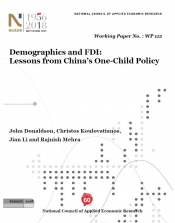Demographics and FDI: Lessons from China's One-Child Policy
Rajnish Mehra
John Donaldson
Christos Koulovatianos
Jian Li
January 2018
Lucas (1990) argues that the neoclassical adjustment process fails to explain the relative paucity of FDI inflows from rich to poor countries. In this paper we consider a natural experiment: using China as the treated country and India as the control, we show that the dynamics of the relative FDI flows subsequent to the implementation of China's one-child policy, as seen in the data, are consistent with neoclassical fundamentals. In particular, following the introduction of the one-child policy in China, the capital-labor (K/L) ratio of China increased relative to that of India, and, simultaneously, relative FDI inflows into China vs. India declined. These observations are explained in the context of a simple neoclassical OLG paradigm. The adjustment mechanism works as follows: the reduction in the (urban) labor force due to the one-child policy increases the savings per capita. This increases the K/L ratio and reduces the marginal product of capital (MPK). The reduction in MPK (relative to India) reduces the relative attractiveness of investment in China and is thus associated with lower FDI/GDP ratios. Our paper contributes to the nascent literature exploring demographic transitions and their effects on FDI flows.
National Growth and Macroeconomic Centre







